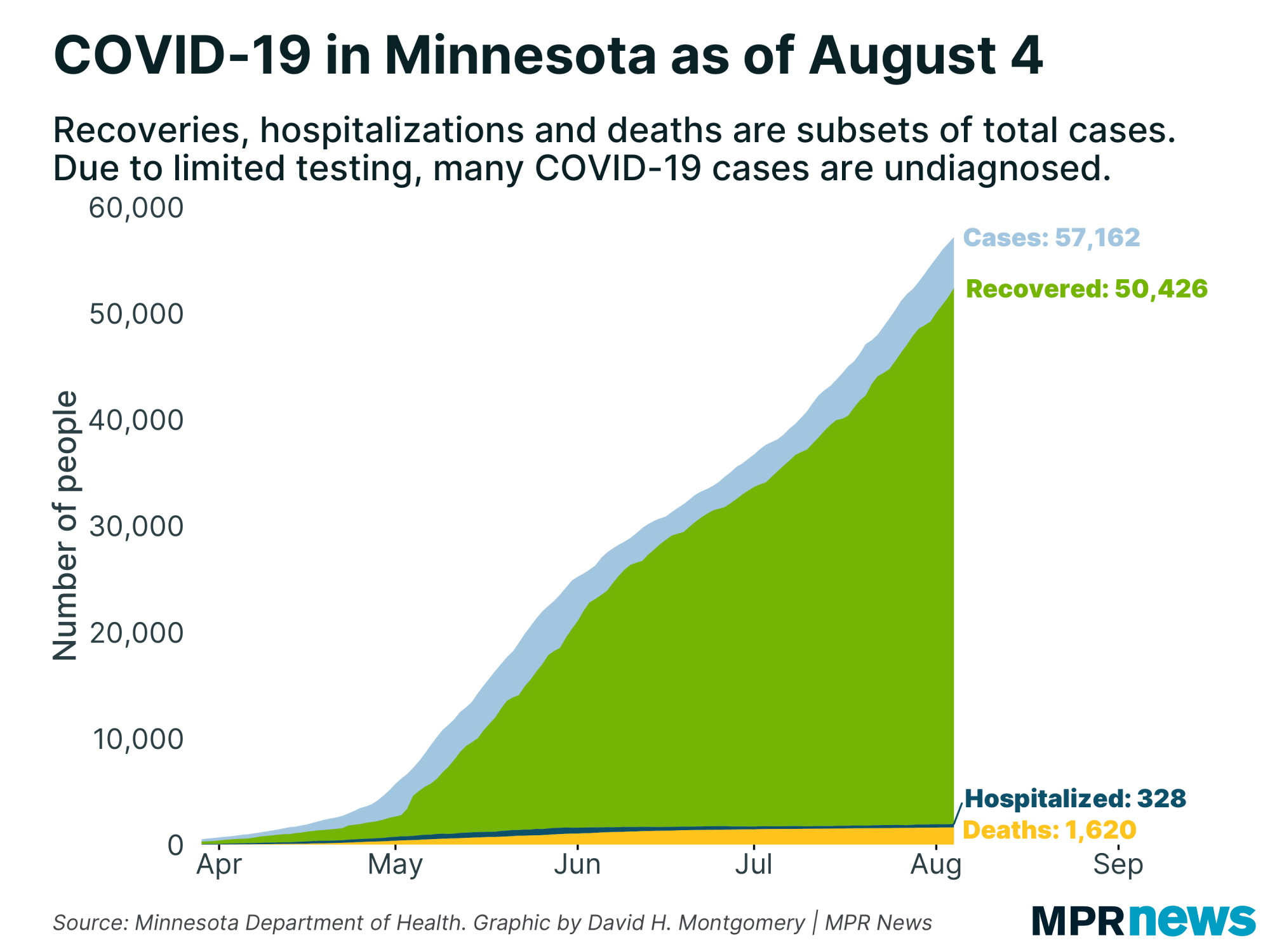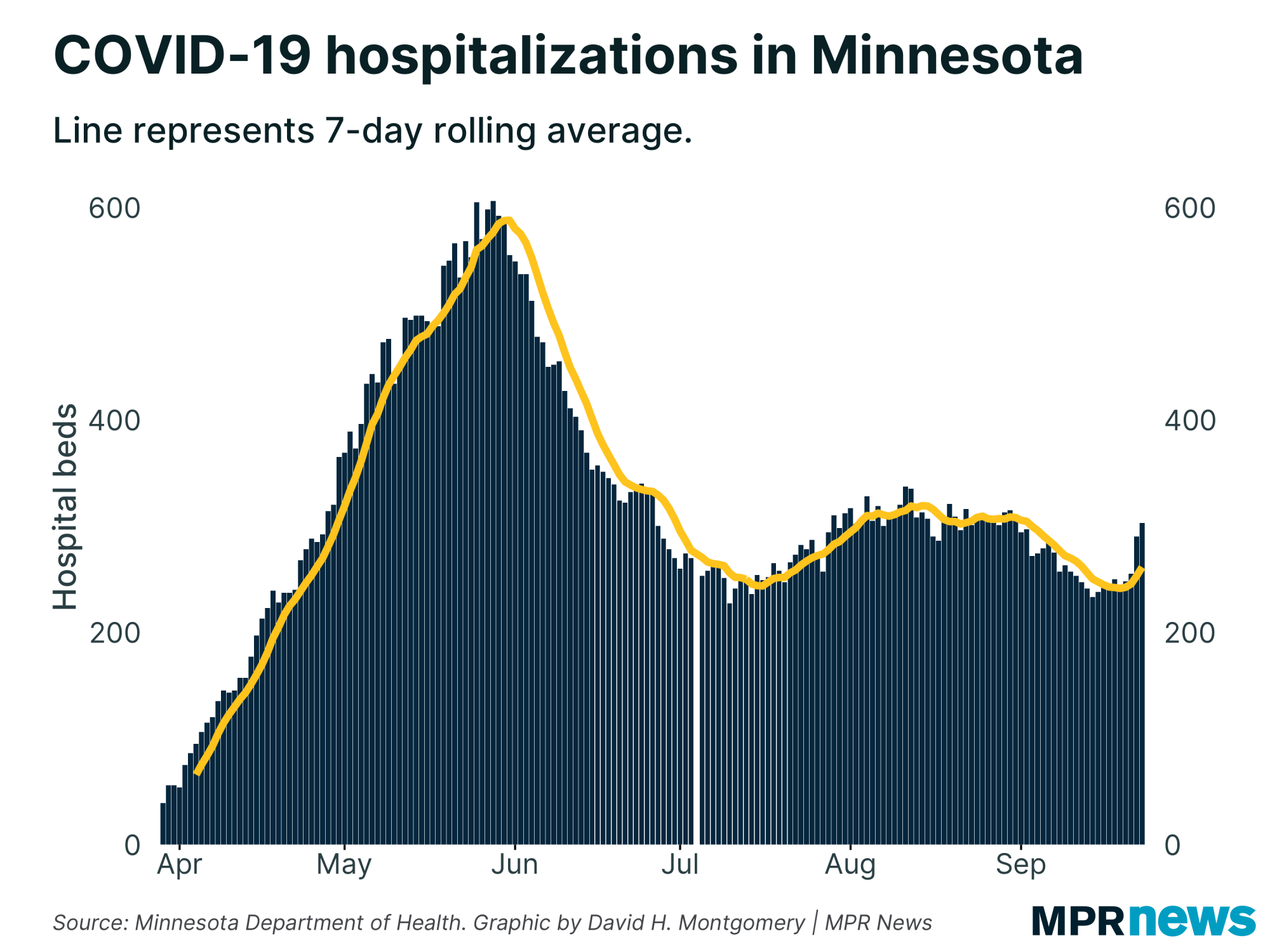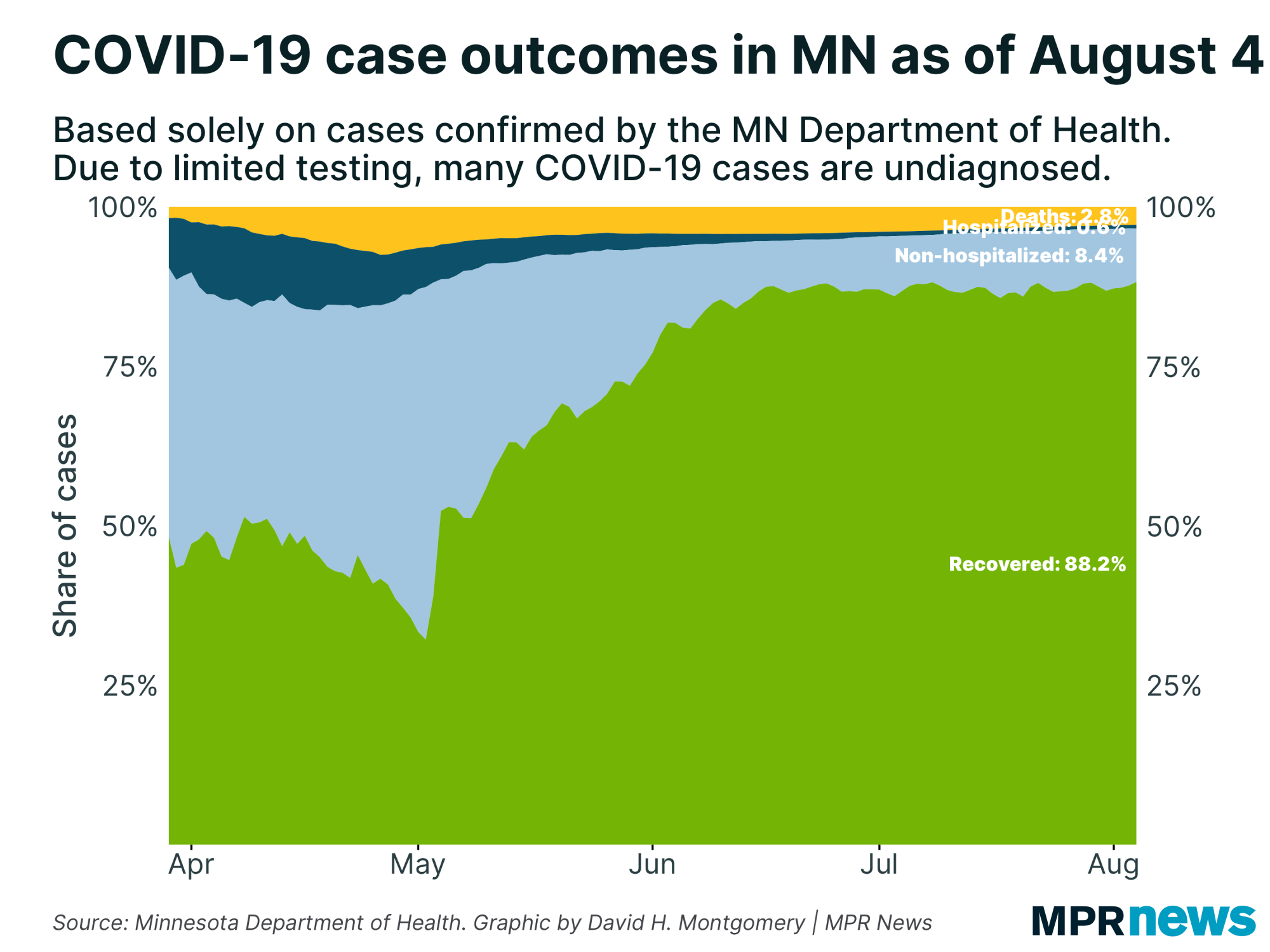July 17 update on COVID-19 in MN: Nothing 'off the table' as case counts climb

Go Deeper.
Create an account or log in to save stories.
Like this?
Thanks for liking this story! We have added it to a list of your favorite stories.
Updated 4:10 p.m.
State health officials on Friday made clear that Minnesota may need to dial back reopening efforts on bars, restaurants and other public gathering spaces if current COVID-19 case trends accelerate and the state continues backsliding in its fight against the disease’s spread.
They also braced Minnesotans to expect the recent relatively stable counts of hospitalizations, intensive care cases and deaths to resume a steeper upward climb.
“It’s extremely likely” that Minnesota will see hospitalizations and intensive care cases on the upswing, possibly as soon as next week, Kris Ehresmann, the state's infectious disease director, told reporters.
Investigators, she said, anticipated a pattern of Minnesota outbreaks clustered around bars as they began to reopen to indoor service over the past few weeks, one that would surface in Mankato, Minneapolis, St. Cloud, Duluth and Bemidji. It happened as expected.
Turn Up Your Support
MPR News helps you turn down the noise and build shared understanding. Turn up your support for this public resource and keep trusted journalism accessible to all.

She and others have warned for weeks that while the young adults who’ve been driving much of the recent case increase may not suffer the worst effects of the disease, they may inadvertently spread it to grandparents and other potentially more vulnerable people.
Community spread — where officials can’t trace the precise path of an infection — is a growing concern.
No moves ‘off the table’
State investigators since Monday have received some 120 complaints from concerned residents reporting violations of the current orders around gathering in indoor social spaces, particularly bars and restaurants, Health Commissioner Jan Malcolm told reporters Friday.
The complaints include staff not wearing masks, not enough social distancing and too many people at a site.
The state is now stepping up enforcement, she said, “not to play gotcha with restaurants and bars but because we so strongly that following these requirements is so essential to help reduce the spread of COVID-19 … and frankly, to increase our chances of keeping the spread of COVID to a low enough level that we can avoid pretty drastic dialbacks.”

Malcolm said most bar and restaurant owners who’ve been flagged have responded positively but also noted that establishments that don’t comply are subject to cease and desist orders.
Malcolm said health officials continue to hope that bars, restaurants and other indoor social spaces get the message. The state, she said, is working to avoid “wholesale closure” of these places but that the rise in community spread must be checked.
“But in all candor, I don't think anything can be considered completely off the table with what we're seeing around the country and in our own numbers in Minnesota,” she added. “But we clearly would like to explore intermediate measures before that.”
Malcolm’s remarks came hours after her agency reported seven more deaths, putting the toll at 1,533 since the pandemic began. Total current hospitalizations (252) and the count of people currently needing intensive care (110) ticked up from Wednesday.
Despite the uptick in ICU cases — a crucial metric as officials try to manage the disease’s spread so it doesn’t overwhelm the care system — average counts the past few days remain at levels not seen since mid-April.
Officials worry, though, those relatively good numbers have lulled too many Minnesotans into complacency.
Cases growing in most age brackets — and up north
State health officials continue to worry about the recent spike of coronavirus cases in younger Minnesotans, with current fears including that those infected will inadvertently spread the virus to more vulnerable populations.
Minnesotans in their 20s now make up the age group with the most confirmed cases, with more than 10,400 since the outbreak started. The median age of Minnesotans infected has been trending down in recent weeks and is now below 38 years old.
Young people still account for the majority of new confirmed cases in Minnesota, although 20-somethings have fallen from around 40 percent of new cases a few weeks ago.

While current hospitalization counts in Minnesota remain relatively low, “we are likely going to see increases in hospitalizations because of the ripple effect” of younger people becoming infected, Ehresmann said earlier in the week, adding that young adults “don’t live in a vacuum.”
The latest numbers, though, show COVID-19 cases have gone up significantly the past few days in every age bracket except people over 60.
Counts also reveal the disease is finally reaching northern Minnesota in significant numbers.
Cases are growing as quickly now in there, on a per capita basis, as they were in the Twin Cities suburbs a month ago.

Of the 45,013 confirmed cases of COVID-19 in Minnesota since the pandemic began, about 86 percent of those people have recovered to the point they no longer need to be isolated.
Among the people who’ve died, nearly 80 percent had been living in long-term care or assisted living facilities, nearly all had some chronic health problem.
Worries grow over another equipment shortage
State health officials this week have expressed concern about running short on protective equipment for health care workers as well as the supplies needed to test for COVID-19. They said they were moving to bolster those supplies.
Along those lines, Ehresmann on Friday said the Health Department has been getting reports of some businesses, child care operations and youth sports camps requiring people to test negative for COVID-19 before returning.
The department, she said, is discouraging such testing.
Officials worry that such testing is using up testing supplies needlessly — testing supplies are strained nationally due to massive outbreaks in other states — and won’t help companies or youth sports operate disease-free.
“A negative test only means that you are negative on that day, and you certainly could be positive on the very next day,” Ehresmann told reporters Friday, adding that the agency wants to prioritize tests for Minnesotans with symptoms or who’ve had known COVID-19 exposure.
She said anyone displaying COVID-19 symptoms should isolate for at least 10 days after the symptoms began and go at least three days without symptoms or a fever.
Walz weighing statewide mask order
As they’ve done consistently in the pandemic, Malcolm and Ehresmann continued on Friday to implore Minnesotans to stay vigilant to slow the spread of COVID-19.
So far, state leaders have emphasized personal responsibility when it comes to mask-wearing, social distancing and hygiene. DFL Gov. Tim Walz is weighing a statewide mask mandate, but has yet to enact one — despite pleas from medical groups and the state Health Department.
Walz expressed concern earlier this week that Minnesotans were lagging on their mask-wearing. But Republicans, including Senate Majority Leader Paul Gazelka, R-East Gull Lake, have said a statewide mandate would be a mistake.

On Friday morning, Walz told MPR News that he believes a mask mandate is the right thing to do to slow the spread of the coronavirus but that he hasn't yet made a decision on whether to issue a statewide order.
"I'm trying to get them to buy in,” Walz said of Gazelka and others who oppose a statewide mandate. “It's unfortunate that around masks, it became somewhat of a political statement rather than a public health statement.”
More than half of US states now require the use of masks or face coverings in public settings.
Minnesota still working on back-to-school plan
During the Friday MPR News interview, Walz also said state officials are still working on a plan on whether to reopen schools to in-person learning this fall.
The governor said students need to be back in school, but added that there were many complicating factors to consider, including the health risks to students, teachers and staff.
"It's a challenge because parents wants to know,” he said. He offered an example of one plan where children in younger grades would return to in-person instruction, middle grades would use a “hybrid” model older students could potentially work online. He conceded: “That's extremely complicated because a lot of families have a child in each grade.”
The federal Centers for Disease Control and Prevention has delayed releasing expected guidance for schools on how to reopen to students.
Meatpacking hot spots remain
Many of the outbreaks outside the Twin Cities metro area are focused around meatpacking plants. Officials have intensified testing in those hot spots, uncovering more infections.
That includes Mower County in southeastern Minnesota, where there were 999 confirmed cases as of Friday. Mower County is home to Hormel Foods and Quality Pork Processors. Both have been partnering with Mayo Clinic to ramp up employee testing.
While some of Mower County’s positive cases are associated with people who work in the facilities and with the people they live with, county officials say they are also seeing transmission among people who live in the county but work in other counties where coronavirus is present.
Nobles, in southwestern Minnesota, reported 1,702 confirmed cases as of Friday, with six deaths. About 1 in 13 people now have tested positive for COVID-19 in the county since the pandemic began, although the count of new cases has slowed considerably in recent weeks.
Worthington’s massive JBS pork processing plant was the epicenter of the Nobles outbreak. The JBS plant shut on April 20 but has since reopened with expanded hygiene and health monitoring measures.

Similar problems have been reported in Stearns County, where COVID-19 cases tied to two packing plants — Pilgrim’s Pride poultry plant in Cold Spring and Jennie-O Turkey in Melrose — skyrocketed in May. An undisclosed number of workers at both plants have tested positive for the virus.
There were about 55 confirmed cases in Stearns County in early May. By Friday, confirmed cases were at 2,615 with 19 deaths.
Kandiyohi County in west-central Minnesota is also dealing with a significant caseload more than two months after officials with the Jennie-O turkey processing plant there said some employees had tested positive for the coronavirus.
As of Friday, the Health Department reported 610 people have now tested positive. The county had confirmed three COVID-19 cases in late April.
Cases have also climbed noticeably in Lyon County (371 cases), around a turkey processor in Marshall.

Developments from around the state
Caribou Coffee to require masks starting next week
Another Minnesota-based business chain is mandating face coverings for customers. Caribou Coffee says masks will be required to enter all company-owned locations starting Monday. Exceptions will be made for young children and people with medical exemptions.
People who do not have masks can still use the drive-thru or curbside pickup.
Earlier this week, Minnesota-based Best Buy and Target announced mask requirements for customers. Caribou competitor Starbucks also is requiring face coverings in its company-owned locations.
And the Super One grocery chain in northern Minnesota has announced it's requiring face coverings, effective immediately.
— Andrew Krueger | MPR News
Teens press Minnesota lawmakers on jobless aid
High school-aged students shut out of work due to the pandemic are pleading with Minnesota lawmakers to make them eligible for unemployment aid.
State law prevents the students 16 and older from collecting benefits.
Cole Stevens of the youth-led Don’t Forget US Campaign told a House committee Friday that he was laid off from his food service job due to COVID-19 closures. He contributes to household bills.
Stevens, 18, of Bloomington, said he received some jobless aid but that was later retracted when the state determined him to be ineligible. When working, he uses his earnings to contribute to household bills.
“I’m not just some lazy teenager trying to maximize his welfare here,” Stevens said. “I needed that money back then when I was in high school and I wasn’t able to get it.”
A bill pending in the Legislature’s special session would allow student workers to qualify for benefits. The proposal would be only a temporary fix that covers March through December of this year.
The House Jobs and Economic Development Finance Committee advanced the bill on a 9-6 vote. The Minnesota Department of Employment and Economic Development, which administers unemployment benefits, supports the change.
DEED Commissioner Steve Grove urged lawmakers to revise a law dating to the 1930s that prevents young workers from qualifying for unemployment.
“If you’re old enough to work, you should be old enough to get unemployment benefits when you can’t work,” Grove said.
Grove said Minnesota is “way behind” many other states have already adjusted their laws to account for displaced young workers.
“These aren’t just aren’t kids with summer jobs for fun. For many of these students these unemployment benefits are primary or at least secondary breadwinners for their family,” Grove said. “That money is going into food on the table, clothes on their backs, keeping those families sustained throughout really challenging times. And when they can’t work, it is all that more challenging.”
Competing House and Senate proposals differ over whether the money would come from a federal relief program or the standard unemployment fund.
— Brian Bakst, MPR News
Walker Art Center, Mia reopen after COVID-19 closures
Two of the state’s best-known museums are reopening Thursday, after months of being closed due to the coronavirus.
The Walker Art Center is reopening for limited hours Thursday through Sunday. The museum is requiring tickets for all visitors, with designated times to help facilitate social distancing. The first hour of tickets on Thursdays and Fridays will be for people with elevated risk of serious illness due to COVID-19.
The Minneapolis Institute of Arts is also reopening Thursday, with similar restrictions, and special hours on Thursdays for people at higher risk for COVID-19.
Tickets for both museums are available online or by phone.
— Tim Nelson | MPR News
Spurred by pandemic, Black Bear Casino in Carlton goes smoke-free
The Fond Du Lac Band of Lake Superior Chippewa has banned smoking at its main casino in Carlton, a major step from standard practice at tribal gaming operations in Minnesota.
The ban went into effect Wednesday morning in all buildings at the Black Bear Resort Casino which sits next to Interstaste 35 south of Cloquet, Minn. The outright ban is unprecedented among high-profile tribal gaming operations in Minnesota. The Fond Du Lac band prohibited smoking at its much smaller casino in downtown Duluth a month ago.
Black Bear general manager Daniel George LaPrairie said the decision was in part because people smoking were not wearing masks, prompting concern about the potential spread of COVID-19.
“Employees and guests and the community are the forefront of our thoughts here. We are definitely concerned with the health and well being of our community,” he said. “This is a step in the right direction, and we’ll keep making those steps in those decisions to keep us safe here.
LaPrairie said the decision was temporary, but that it may last beyond the COVID-19 outbreak. He said cultural attitudes both in Native and wider communities were moving against smoking, and that he believes tribal gaming may take wider action against the practice.
— Tim Nelson | MPR News
Top headlines
3M file suit for price gouging of N95 masks: The Twin Cities-based manufacturing giant and leading maker of N95 masks in the country says it has investigated 4,000 reports of fraud, counterfeiting and price gouging in connection with the product and has filed 18 lawsuits.
Target, CVS Health join list of major retailers mandating masks: Target, CVS Health and Publix Super Markets on Thursday joined the growing list of major retailers that will require customers to wear masks as cases of COVID-19 spike. Target's policy will go into effect Aug. 1., while CVS's rule will start Monday.
COVID-19 in Minnesota
Data in these graphs are based off Minnesota Department of Health cumulative totals released at 11 a.m. daily. You can find more detailed statistics on COVID-19 at the Health Department website.
The coronavirus is transmitted through respiratory droplets, coughs and sneezes, similar to the way the flu can spread.


